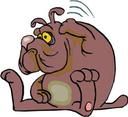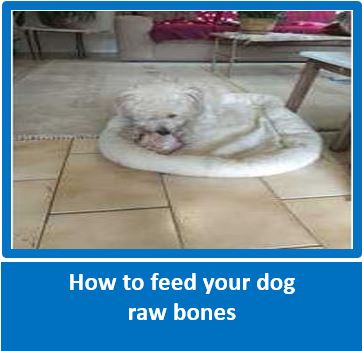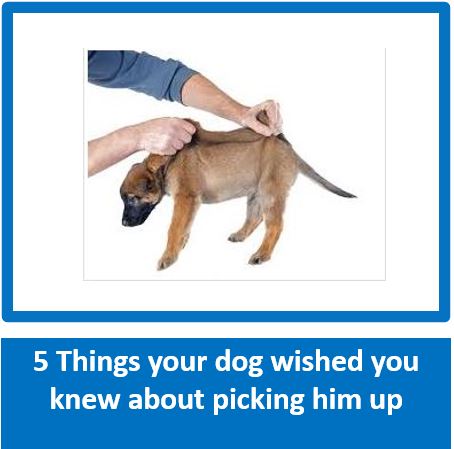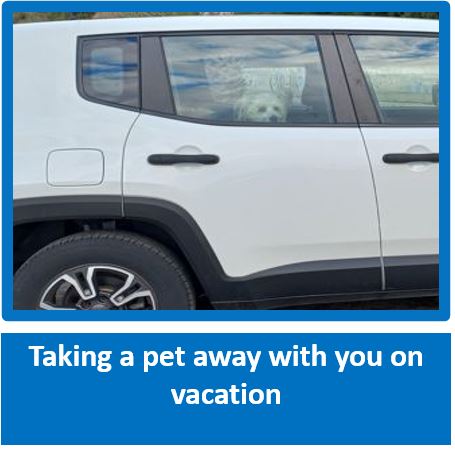
Please visit and LIKE our Facebook Page and share with family, friends and on your own Facebook page, and ask them to share further – it is only by working together and sharing knowledge and education that we can improve the lives of dogs and assist owners. We do not inundate you with posts – an average of 5 per week, and the odd Did You Know and General Post. Thank You!
Why do I need to get my pup used to different noises?
By Scotty Valadao – Friends of the Dog - Canine Behaviourist
(Habituation can be described as the process whereby an animal becomes
accustomed to non-threatening stimuli and learns to ignore them –
David Bailey)
accustomed to non-threatening stimuli and learns to ignore them –
David Bailey)

Do I need to get my pup used to different noises? The quicker and the more the better, and this is why.
Pups have what is called a period of 'critical development' which is from about 3 - 16 weeks of age (about 18 weeks in the bigger breeds), and during this period they can mostly be habituated to accepting different noises, locations, new social experiences etc, than any other time of their lives - after the 16 week period, it is much harder for a pup to accept novel or new noises, experiences etc into their lives. Do take advantage of this period.
When we speak about dogs auditory abilities, we need to realize the extent of their hearing abilities. Not only do dogs have the ability to hear and discriminate between wide ranges of sounds, they can distinguish same at approximately four times the range of us humans. Their inner ears are designed in a manner that not only do they hear more, they can operate their ears almost like radar – they can hear the sounds but can also perceive the height and depth of the sound that they do hear. They are able to hear ultra high frequencies that we humans cant (the dog whistle for example) and they can pin point exactly where the sound originated from.
Habituation to different noise should not be a haphazard affair (indeed the same can be said with socialization); it should be approached from a systematic point of view with the pup being exposed to as many different noises as possible as often as possibility. As pups do go through different fear periods, you need to make these experiences as positive as possible for the pup, ignoring or desensitizing the pup if a fear response does occur. What is crucial to remember is that this must always be a positive experience for the pup, never a frightening one, as this can have a life long impact.
Things that can be done in the home
Visitors: Introduce the pup to as many people, being as noisy as possible. Even go to the extent of having a braai with your hubby’s rowdy rugby mate (the type you normally can’t stand!). If you have young children, have their friends over and let them engage in noisy play, even playing with drums and trumpets. Have the pup safely in the crate or being held by owner, on lead, with a nice chewy to get busy with.
Noises in the home:The burglar alarm, banging pots and pans, the radio blasting, the vacuum cleaner, washing machine and tumble dryer, the door bell etc, in fact anything you can think of. I know an adult dog that although it loved its food, it used to cringe when the food bowl was placed on the floor as it was metal and made a noise. Don’t limit to noises inside the home, think about what comes out of the garage – drills, lawn mover, weed eaters and so forth. Get the pup used to the postman, the rubbish truck, and the rubbish collectors.
Away from the home: As early as possible the street. We come across so many dogs who can tolerate being in the car, but go nuts when motor bikes, trucks and the like come past. Start with quieter streets and build up to the busy ones. Again you can supply a safe chewy to entertain the pup and distract it.
Any place where people congregate. This can be shopping centres, vets room (which are often noisy) and especially schools. Have you ever realized the noise that kids make when the home bell, or play time bell rings?
This one may sound a bit strange, but try and have the dog exposed to heavy winds. On the same point, try and take the pup to a garage so that it can experience the smells and noises and especially the tear drop flags that garages have advertising different products. These make a strange noise in the wind. I speak here from experience!
What about the countryside? Although the pup may not be one that goes out riding with the owner, it may well be exposed to the mooing of a cow or braying of a donkey etc.
Storm Phobia Habituation: As fear of storms is such a major problem in South Africa, unless an owner has no possible alternative, we would always recommend purchasing a new puppy during our rainy/storm season. Yes, you can help a pup to be desensitized to the noise a storm makes, but a CD with all the sounds of a storm does not take the place of the other factors that accompany storms – change in Ions, static electricity, howling wind, trees bending, hail, the sound of rain on a metal roof, and of course the thunder and lightening. We need to realize that a phobia can be caused from a single experience (this is called one event learning) or even from continued exposure to the fearful stimulus.
Some pups may only exhibit mild fear responses such as panting, pacing or hiding behind an object, and these are the pups that tend to develop full storm fear phobia if the problem is not attended too, as the odds are that the fear will get worse! Other pups may get so panicked that it can result in destruction, elimination and/or defecation or really injuring themselves trying to get away from the perceived threat. If you have ever thought that this is not a serious problem, all one has to do is to see a dog that has storm phobia to realize that owners must do as much as possible to safeguard their pups from suffering from this terrifying phobia. If the pup is showing any stress at all when a storm is approaching, rather than leaving the pup to cope, the owner would immediately start with some desensitizing by engaging in a game to occupy the pup or preferably, call in a professional to attend to this immediately before it becomes a full blow phobia.
Fireworks: This is another area where severe phobias can develop, and is much easier to desensitize a pup too as you can buy CD’s which contain the sounds of fireworks on them. When using these CD’s make sure that it is started at a low volume and gradually turn the volume up. At the same time, use desensitization to turn this into a pleasurable experience for a pup, even playing outside with it as long as the people next door are not letting off fireworks which may result in the pup being startled.
Don’t limit yourself to the suggestions above, become more aware of your surroundings and start to recognize the different noises around you. So many of these have become common place that we treat them as white noise – they don’t exist. Rather try to ‘hear’ our complicated world through your pup’s ears and be inventive.
Pups have what is called a period of 'critical development' which is from about 3 - 16 weeks of age (about 18 weeks in the bigger breeds), and during this period they can mostly be habituated to accepting different noises, locations, new social experiences etc, than any other time of their lives - after the 16 week period, it is much harder for a pup to accept novel or new noises, experiences etc into their lives. Do take advantage of this period.
When we speak about dogs auditory abilities, we need to realize the extent of their hearing abilities. Not only do dogs have the ability to hear and discriminate between wide ranges of sounds, they can distinguish same at approximately four times the range of us humans. Their inner ears are designed in a manner that not only do they hear more, they can operate their ears almost like radar – they can hear the sounds but can also perceive the height and depth of the sound that they do hear. They are able to hear ultra high frequencies that we humans cant (the dog whistle for example) and they can pin point exactly where the sound originated from.
Habituation to different noise should not be a haphazard affair (indeed the same can be said with socialization); it should be approached from a systematic point of view with the pup being exposed to as many different noises as possible as often as possibility. As pups do go through different fear periods, you need to make these experiences as positive as possible for the pup, ignoring or desensitizing the pup if a fear response does occur. What is crucial to remember is that this must always be a positive experience for the pup, never a frightening one, as this can have a life long impact.
Things that can be done in the home
Visitors: Introduce the pup to as many people, being as noisy as possible. Even go to the extent of having a braai with your hubby’s rowdy rugby mate (the type you normally can’t stand!). If you have young children, have their friends over and let them engage in noisy play, even playing with drums and trumpets. Have the pup safely in the crate or being held by owner, on lead, with a nice chewy to get busy with.
Noises in the home:The burglar alarm, banging pots and pans, the radio blasting, the vacuum cleaner, washing machine and tumble dryer, the door bell etc, in fact anything you can think of. I know an adult dog that although it loved its food, it used to cringe when the food bowl was placed on the floor as it was metal and made a noise. Don’t limit to noises inside the home, think about what comes out of the garage – drills, lawn mover, weed eaters and so forth. Get the pup used to the postman, the rubbish truck, and the rubbish collectors.
Away from the home: As early as possible the street. We come across so many dogs who can tolerate being in the car, but go nuts when motor bikes, trucks and the like come past. Start with quieter streets and build up to the busy ones. Again you can supply a safe chewy to entertain the pup and distract it.
Any place where people congregate. This can be shopping centres, vets room (which are often noisy) and especially schools. Have you ever realized the noise that kids make when the home bell, or play time bell rings?
This one may sound a bit strange, but try and have the dog exposed to heavy winds. On the same point, try and take the pup to a garage so that it can experience the smells and noises and especially the tear drop flags that garages have advertising different products. These make a strange noise in the wind. I speak here from experience!
What about the countryside? Although the pup may not be one that goes out riding with the owner, it may well be exposed to the mooing of a cow or braying of a donkey etc.
Storm Phobia Habituation: As fear of storms is such a major problem in South Africa, unless an owner has no possible alternative, we would always recommend purchasing a new puppy during our rainy/storm season. Yes, you can help a pup to be desensitized to the noise a storm makes, but a CD with all the sounds of a storm does not take the place of the other factors that accompany storms – change in Ions, static electricity, howling wind, trees bending, hail, the sound of rain on a metal roof, and of course the thunder and lightening. We need to realize that a phobia can be caused from a single experience (this is called one event learning) or even from continued exposure to the fearful stimulus.
Some pups may only exhibit mild fear responses such as panting, pacing or hiding behind an object, and these are the pups that tend to develop full storm fear phobia if the problem is not attended too, as the odds are that the fear will get worse! Other pups may get so panicked that it can result in destruction, elimination and/or defecation or really injuring themselves trying to get away from the perceived threat. If you have ever thought that this is not a serious problem, all one has to do is to see a dog that has storm phobia to realize that owners must do as much as possible to safeguard their pups from suffering from this terrifying phobia. If the pup is showing any stress at all when a storm is approaching, rather than leaving the pup to cope, the owner would immediately start with some desensitizing by engaging in a game to occupy the pup or preferably, call in a professional to attend to this immediately before it becomes a full blow phobia.
Fireworks: This is another area where severe phobias can develop, and is much easier to desensitize a pup too as you can buy CD’s which contain the sounds of fireworks on them. When using these CD’s make sure that it is started at a low volume and gradually turn the volume up. At the same time, use desensitization to turn this into a pleasurable experience for a pup, even playing outside with it as long as the people next door are not letting off fireworks which may result in the pup being startled.
Don’t limit yourself to the suggestions above, become more aware of your surroundings and start to recognize the different noises around you. So many of these have become common place that we treat them as white noise – they don’t exist. Rather try to ‘hear’ our complicated world through your pup’s ears and be inventive.




